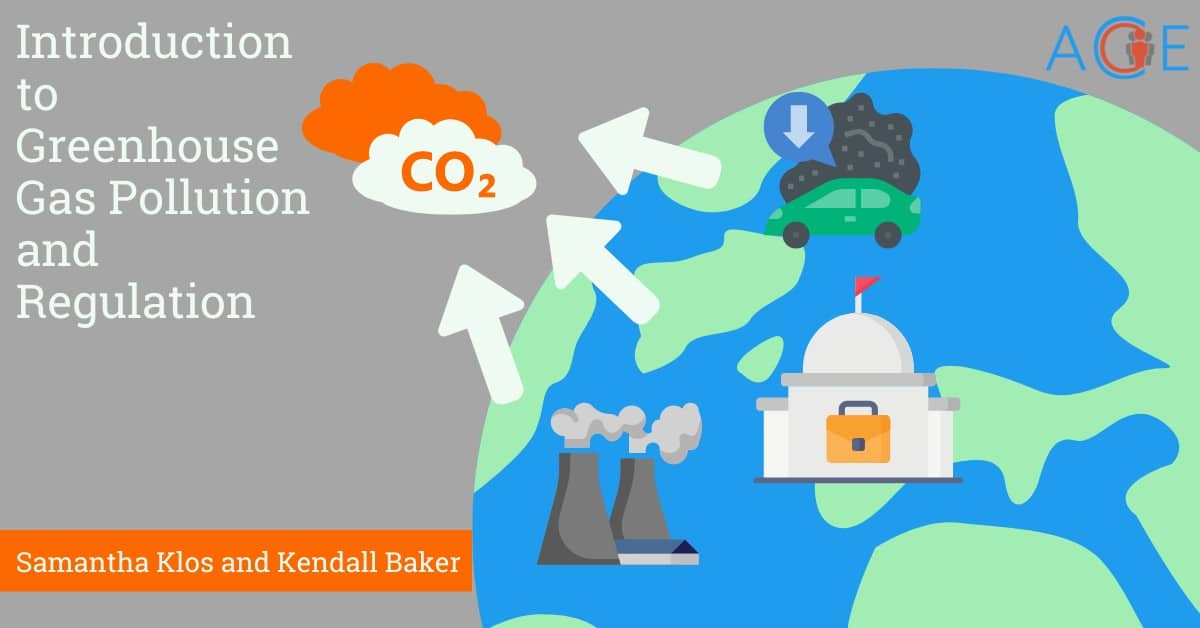Introduction
Greenhouse gas pollution is a main contributor to climate change. Carbon dioxide and methane are examples of greenhouse gas pollutants, and human activities such as energy production and transportation emit them (see Figures 1 and 2). The Intergovernmental Panel on Climate Change (IPCC) has declared that global greenhouse gas emissions must be reduced by 50% by 2030 to prevent catastrophic and potentially irreversible effects of climate change. However, current emissions reductions by governments are not projected to meet that goal.
Corporations, governments, and consumers all contribute to greenhouse gas pollution. One study indicates 100 companies are responsible for 70% of greenhouse gas emissions. In addition, the United States is known to be the “the largest historical emitter” and currently has the second highest rate of greenhouse gas emissions in the world. Therefore, reducing the United States’ greenhouse gas emissions could have a significant impact on climate change.
Current State of Policies in the U.S.
In the United States, national policies regarding greenhouse gas pollution involve federal legislation like the Clean Air Act and international agreements such as the Paris Climate Accords.
- Federal Policies: The Clean Air Act of 1970 is a landmark piece of legislation that called for the implementation of air quality standards. The law tasked the Environmental Protection Agency (EPA) with creating and enforcing limits on air emissions from both mobile and industrial sources. The law also gave regulatory power to individual states, giving them the authority to implement their own programs and monitor or report violators. These measures include the creation of National Ambient Air Quality Standards, State Implementation Plans, New Source Performance Standards, and National Emission Standards for Hazardous Air Pollutants. In 2007, the U.S. Supreme Court ruled that the definition of “air pollutants” includes greenhouse gasses, giving the EPA a stronger basis for arguing for the mitigation of climate change through pollutant regulation. The Energy Act of 2020 is another major federal law seeking to combat climate change through energy efficiency and innovation. Its main goals are to increase energy efficiency, modernize the energy grid, and advance research and development in renewable energy, nuclear energy, and carbon capture technologies. Specifically, it directs the Department of Energy to research and develop energy storage, nuclear, geothermal and carbon-capture technologies to advance a gradual shift away from fossil fuels.
- International Agreements: The Paris Agreement is an international accord that seeks to limit climate change to within 1.5°C. The agreement was adopted in 2015 by 197 countries, including the United States. Nations submitted emission reductions targets, or intended nationally determined contributions (INDCs), and these commitments are expected to strengthen overtime. For transparency and accountability purposes, the Paris Agreement keeps record of progress updates. While the Trump Administration withdrew the United States from the Paris Agreement, the Biden Administration rejoined and committed to reducing emissions “by 26 to 28 percent below 2005 levels by 2025.”
- State Policies: There are many non-federal policy options and proposals for greenhouse gas regulation. They include carbon pricing frameworks like carbon taxes or cap-and-trade programs, national or state-level renewable energy portfolio standards, energy resource efficiency standards, and tax credits for individual incentivization.
Arguments for Government Regulation of Greenhouse Gasses
The majority of US residents view climate change as a major threat and many have called for greater government involvement in tackling it. Although individuals are taking steps to reduce their emissions, a large proportion of emissions comes from corporations and industrial activity. Proponents of greenhouse gas regulations argue government involvement is necessary to reduce emissions because governments have the power to regulate companies in a way that individuals do not. For example, the government has the authority to impose carbon pricing frameworks, enforce emission reduction deadlines, and hold industries accountable for violations of clean air laws.
The Build Back Better Act is the most significant proposition addressing climate change in American history. Energy efficiency projects, electric vehicles, and climate change research would all receive funding from the bill. In addition, the act would provide jobs for citizens by guaranteeing clean energy technologies and materials be made here in the United States. Lastly, the Build Back Better Act proposes strategies to reduce the cost of transitioning to clean energy, and make eco-friendly living more accessible to middle class families. The Build Back Better Bill has stalled in the Senate, and it is not currently expected to be passed into law.
Economic Concerns
Most of the American public, including over 75 percent of Republican voters, is concerned about the threat of climate change and supports some sort of greenhouse gas regulation. However, Republican legislators remain firmly opposed to greenhouse gas regulations, citing mainly economic concerns. The resistance stems from a desire for U.S. energy self sufficiency, avoiding rising household consumption costs, and ensuring grid stability.
Many supporters of deregulation are impressed by the economic benefits the United States enjoyed from an increase in oil and natural gas production; they point to increased competitiveness in international markets, added domestic jobs, and a more favorable balance of trade. Some argue energy policy should be an ‘economics leads’ approach, meaning the sector should prioritize first and foremost economic potential while demand is high, and if it decreases, oil and gas consumption may phase out on its own. Through this lens, they assert that increased greenhouse gas regulation in the U.S. will not aid in achieving emissions goals; rather, it will increase imports and dependence on energy sources globally. Therefore, the environmental impact of oil/gas production may be higher once transportation emissions and potentially less regulated foreign replacement fuel emissions controls are accounted for. In theory, by following economics and halting regulation, emissions will gradually decline and economic shocks can be avoided.
Others argue that the costs of increased regulation are too high for common people and families when compared to the predicted benefit of increased bureaucratic regulations. Some conservatives suggest greenhouse gas regulations could raise household energy prices, which would burden households and slow consumption. Opponents of greenhouse gas regulation argue that carbon pricing could cause a twofold problem for average Americans: first, that it would destroy American jobs, leading to outsourcing, and second, that energy producers would pass on the cost of carbon pricing to consumers.
Finally, critics highlight concerns over the stability of the electricity grid as renewable energy becomes increasingly common. Electricity generation from wind and solar resources are highly variable, which some argue poses risks to the energy grid’s reliability. Skeptics of renewable energy have also blamed renewable energy for large-scale blackouts, like those in Texas in February 2021. Overall, opponents of greenhouse gas regulations have long pointed to the risks of grid instability and economic harm in arguing against governmental regulation and renewable energy production.
Future Regulation
Future regulations are uncertain as the pending Supreme Court Case, West Virginia vs. EPA, has the potential to undermine the current scope of regulatory ability and power of the EPA and the federal executive branch. The case challenges their authority to regulate greenhouse gas emissions under the Clean Air Act, and observers expect the Court to rule against the EPA. The ultimate decision will be indicative of the level of climate action that the Biden Administration can accomplish and the future of greenhouse gas regulation in the United States.
The international community is already designating specific environmental concerns to the United Nations Climate Change Conference 27th Session Conference of Parties (COP27) agenda. The main action areas for this conference are emissions reduction, with a specific call on the U.S. and other G20 nations to take leadership positions. Governments have also agreed on the need to address climate change impacts, adaptation, and climate finance at large. The UN has highlighted the urgency of these greenhouse gas emissions reduction goals and the combined commitment of governments, civil society, and the private sector in order to meet the 1.5°C ambition.


